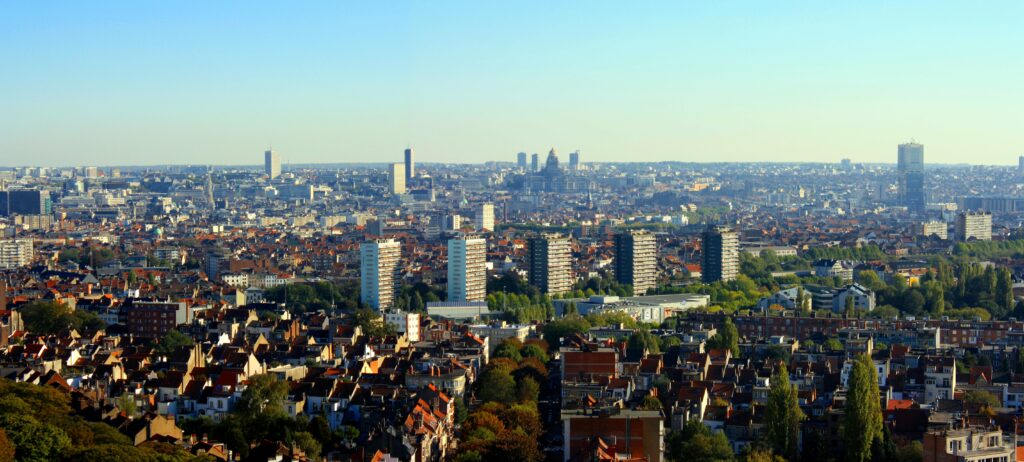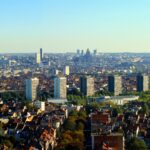
In recent years, the concept of smart city or intelligent city has become widely popular in different spheres of society (media, academic, political, etc.). There seems to be a consensus in the political field, both on the right and on the left. But what does this concept cover? Is the smart city really an integral part of solutions towards a more sustainable future?
The idea dates from the 80s and 90s and initially came from the private sector. At that time, the large NICT multinationals [1]New information and communication technologies. (IBM, Cisco Systems, etc.) are looking for new markets and the idea is emerging that a city would become easier to manage thanks to new digital technologies. We place a tipping point around 2005, when the expression “smart city” was used by Bill Gates, boss of Microsoft, in the United States. It challenges digital players to use their technology to optimize the functioning of a city. Private and public interests will then only grow.
This new trend takes place in a particular context. Francois Jarrige [2]François Jarrige is a lecturer in Contemporary History at the University of Burgundy and a specialist in the history of technology. explains it by the situation experienced by cities, particularly those in countries of the South, at the start of the 21st century. On the one hand, they are facing rapid demographic growth. Since 2008, more than half of humanity lives in cities. And in 2050, the planet would have 6.4 billion urban dwellers, i.e. almost two thirds of the world's population (without system breakdown such as violent conflicts, shortages, major economic crisis, etc.). This increase represents a real challenge for cities in terms of management and organization. On the other hand, the city is the place where social, environmental crises, etc. are directly experienced. from the beginning of the century. As a place of concentration of power, the city would be the scene of numerous issues. The smart city would therefore correspond to the meeting between private interests in search of new markets and a moment of crisis in cities in search of solutions.
And these solutions would be found, according to these actors, in new technologies and the use of digital data in order to optimize the services offered by the city and to encourage residents to change their behavior . The definitions and applications of the smart city are multiple. The European Parliament defines it as “a city that seeks to solve public problems through ICT-based solutions, based on a municipal initiative and mobilizing multiple stakeholders [3]Quoted in GINTRAND F. and NGUYEN D., “ The “smart city” is not that “smart” », 08/19/2015. ". And this definition is available in different areas such as the economy, mobility, environment, administration, etc. The collection of data via sensors could, for example, make it possible to optimize the operation of public lighting, the fluidity of travel, manage air pollution, heating in buildings, waste collection, etc.
In 2019, there would be around 1000 smart cities in the world, half of which are in China and around a hundred in Europe. Many French cities have joined the race (Lyon, Nice, Dijon, etc.) with a lot of smart projects to improve their image. In Belgium, the smart city is also enjoying success. The Digital Agency, created by the Walloon government, launched its “Digital for Wallonia” program in 2015 which aims to develop Wallonia’s digital ambition and transformation in a series of sectors: industry, school, health, research, etc. One of its structuring themes is the “connected and intelligent territory”. It is in this group that we find the development of smart cities in Belgium. Brussels has therefore launched its smart city project, just like Liège or Namur. In all, more than 50 cities and towns have embarked on the adventure.
The smart city therefore seems to be a consensus. In the descriptions written by Walloon cities, we find different guidelines intended to frame smart city projects: keeping people at the center of concerns, a city that serves the well-being of citizens, close to those ci, which promotes their participation, integrating everyone, reducing divides, as well as its environmental footprint by reducing its consumption of resources and energy.
All these objectives would be achieved through the use of digital technologies. The digital data produced by our smartphones or various sensors represent the raw material of the smart city. The processing of this Big Data should make it possible to re-transmit useful data (open data) to citizens. Collecting and processing this data requires a significant infrastructure made up of sensors, data centers and telecommunications networks. Finally, software completes this set and is used to transform, thanks to algorithms and computer models, this data into information. [4]See the Brussels Smart Citizen website..
The smart city holds many promises. The first is to become an ecological city using digital tools to optimize city services. In a way, the citizen will not be able to consume less if he/she sees in real time what he/she consumes. So it’s a very individual version of ecology.
Behind this promise, the smart city implies an increase in digital tools and consequently in data traffic. This observation suggests that smart city promoters do not sufficiently take into account the environmental impact of digital technology and are riding on the idea of digital technology being immaterial and therefore without impact. However, it seems essential to us to deny this belief which is still far too widespread today. No, digital is not immaterial; it is based on gigantic infrastructures (boxes, cables, networks, antennas, data centers, equipment, etc.) which depend on numerous non-renewable raw materials (including many metals). Our elected officials far too often forget the complete cycle of electronic equipment and the energy necessary for the extraction of minerals as well as the harmful consequences of their exploitation on the way of life of populations and the environment. [5]See Justice and Peace publications on the subject.. Also, for almost 15 years, studies have affirmed that digital technology is a key element in the fight against global warming. However, the share of digital in GHG emissions is only increasing and is close to 4% in 2020, almost twice as much as the share of civil air transport. This leaves you wondering. Just like the share of electricity mobilized by digital technology at the global level, i.e. between 7 and 10%. And these numbers are only growing [6]See the Justice and Peace study, “the false promises of digital technology” and the studies to which it refers.. The development of smart cities will not lead to a reduction in these trends because it requires an increase in equipment, sensors, computer devices for data processing, etc.
The smart city is also no stranger to the debate on 5G, even if it could happen outside of it. However, it is likely that the promoters of the smart city will see it as going hand in hand with 5G with a view to efficiency gains. [7]Find out more about 5G in the column by Hugues Ferreboeuf and Jean-Marc Jancovici in Le Monde “Is 5G really useful? », January 9, 2020, or in the interview with Hugues Ferreboeuf… Continue reading. To this, we should add attention to rebound effects. It is proven that gains in effectiveness and efficiency in an area lead to an increase in consumption and therefore energy and resources, which ultimately becomes counterproductive. It therefore seems wrong to us that data on the environmental impact of digital technology does not appear in the debates. In-depth studies on this aspect of smart cities seem essential before taking any steps in this direction.
The smart city also promises a democratic renewal. Thanks to the data collected, elected officials would have more information about citizens and could define better adapted policies. Citizens could in turn better interact with their elected officials, thus strengthening citizen participation. Part of the data would be public, would increase transparency and allow citizens to re-appropriate their city. This promise raises certain questions.
It presupposes that all citizens have a smartphone and the ability to access the Internet, which is not the case for everyone (elderly, disadvantaged people, etc. or individuals choosing not to do not have a smartphone). It also presupposes that citizens would a priori be inclined to be monitored and to entrust their personal data to public authorities and their private partners. Because the software and data processing programs, just like the applications offered, will require the assistance of the private companies that distribute them (GAFA, etc.). Will the smart city give citizens the possibility of refusing to have their data collected? Does this generalized surveillance not contain within it the risk of being misused by future less democratic governments? Current political leaders assure that data protection will be a central point of attention in the smart city project. But can we really be sure of this in the face of web giants with gigantic power? How can we define the right place for these profit-seeking actors whose objectives differ from public urban actors?
An underlying question is how this immense data traffic would be managed? Will it be subject to democratic control? What transformation of our democracies does the smart city imply? The smart city could mark the entry into a form of “algorithmic governmentality”, a concept studied by researcher Antoinette Rouvroy. It describes a social world based on algorithmic processing rather than politics, law and social norms. She criticizes “a certain use of data-mining (data exploration) and everything that we place under the sign of artificial intelligence in the service of “sectoral rationalities” aimed at optimizing unsustainable states of affairs (social crisis , environmental) for the benefit of public and private bureaucracies concerned, for some, to no longer assume the burden and responsibility of “deciding” in a situation of uncertainty and, for others, to select and bring about, among the possibilities co-present, the possible which maximizes their interest without it necessarily being aligned with the common interest” [8]See the full article..
In terms of strengthening citizen participation, we would like to emphasize that the smart city refers to a restrictive definition of democracy. It cannot be limited to information flows because nothing can replace “physical” interactions and debates between people. According to François Jarrige, the smart city is based on marketing strategies aimed at making it attractive. Using English is one of them. But even more, the use of the terms “smart-intelligent” constitutes a bias from the start. Intelligence is in fact much more complex than the connection and circulation of information. He notices an impoverishment of the language and the conception of what a city is. Does the smart city suggest that the city “before” was not “intelligent”? How to build quality public policies based on biased language?
The smart city is thus part of the vision of technological solutionism, the only one capable of getting us out of current impasses. Technology would represent scientific progress and progress would necessarily be good and desirable. It appears to be an easy path for elected officials overwhelmed by current issues. It allows us to avoid asking deeper questions about the ills of our society: how can we really fight against social inequalities? Against global warming? What reform of the economic model would be necessary to achieve this?
The path chosen by the environmentalist mayor of Grenoble seems interesting to us to highlight. This has distanced itself from the smart city. “He is opposed to the idea of placing the city in a logic of flow, to insist on the definition of the City as a space of democracy, that is to say “space of conflicts”. To achieve this balance, he suggests working simultaneously on the SC and the “low tech” city. Inspired by Navi Radjou, he speaks of “frugal innovation” which makes it possible to resist shocks such as cyclones or floods. It's about combining technology and democracy [9]GHORRA-GOBIN C., “ Fiction” and strategic innovation. ". The mayor notably organizes citizen workshops called “factories” where he promotes the mix of individuals who discuss a chosen theme, in a bottom-up logic in order to bring out possible solutions for the city of tomorrow.
The principle of Low Tech, developed by various researchers including Philippe Bihouix [10]BIHOUIX Ph., The Age of Low Tech, 2014., seems to us to be an interesting path for the city of tomorrow. Rather than rushing headlong towards the smart city in the name of modernity and progress, it seems essential to us that political decision-makers take the time to ask deeper questions about urban issues, in dialogue with the citizens, and to assess whether the smart city is able to respond to them, based on a range of criteria. “Digital is an accelerator. If we go in the wrong direction, we'll get there faster [11]FERREBOEUF H., “ 5G, environmental impact and economic relevance ". ". It is also fundamental that our leaders measure the challenges and risks in terms of democracy by associating themselves with imposing private actors. Reviewing the definition of the word “progress” by focusing on the purposes of the city taking into account current socio-environmental issues therefore appears to be a priority.
Geraldine Duquenne.
Attachments
Notes[+]
| ↑1 | New information and communication technologies. |
|---|---|
| ↑2 | François Jarrige is a lecturer in Contemporary History at the University of Burgundy and a specialist in the history of technology. |
| ↑3 | Quoted in GINTRAND F. and NGUYEN D., “ The “smart city” is not that “smart” », 08/19/2015. |
| ↑4 | See the Brussels Smart Citizen website. |
| ↑5 | See Justice and Peace publications on the subject. |
| ↑6 | See the Justice and Peace study, “the false promises of digital technology” and the studies to which it refers. |
| ↑7 | Find out more about 5G in the column by Hugues Ferreboeuf and Jean-Marc Jancovici in Le Monde « Is 5G really useful? », January 9, 2020, or in the interview with Hugues Ferreboeuf « 5G, environmental impact and economic relevance » |
| ↑8 | See the full article. |
| ↑9 | GHORRA-GOBIN C., “ Fiction” and strategic innovation. |
| ↑10 | BIHOUIX Ph., The Age of Low Tech, 2014. |
| ↑11 | FERREBOEUF H., “ 5G, environmental impact and economic relevance ". |







